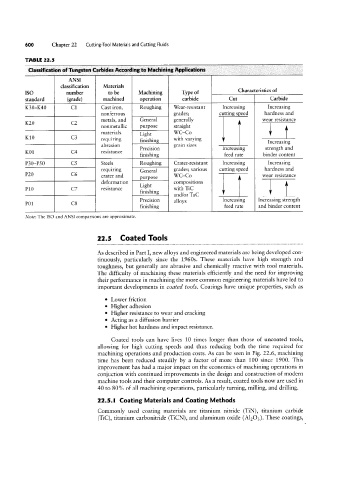Page 619 - 04. Subyek Engineering Materials - Manufacturing, Engineering and Technology SI 6th Edition - Serope Kalpakjian, Stephen Schmid (2009)
P. 619
600 Chapter 22 Cutting-Tool Materials and Cutting Fluids
TABLE 22.5
Classification of Tungsten Carbides According to Maehining Applications
ANSI
classification Materials _
ISO number to be Machining Type of Chafacfeflsflcs of
standard ( rade) machined o eration carbide Cut Carbide
g
P
K3 0-K40 Cast iron, Roughing Wear-resistant Increasing Increasing
nonferrous grades; cutting speed hardness and
K20 metals, and General generally wear resistance
nonmetallic purpose straight
materials Light WC-Co
K10 fequlfmg finishing With varying I
abrasion grain sizes ncreasmg
strength and
K01 resistance Precision Increasing binder content
feed rate
finishing
P30-P50 Steels Roughing Crater-resistant Increasing Increasing
requiring General grades; various cutting speed hardness and
P20 crater and - WC-Co wear resistance
purpose
deformation L_ ht compositions
P10 resistance ,lg with TiC
and/or TaC
P01 Precision alloys Increasing Increasing strength
finishing feed rate and binder content
Note: The ISO and ANSI comparisons are approximate.
22.5 Coated Tools
As described in Part I, new alloys and engineered materials are being developed con-
tinuously, particularly since the 1960s. These materials have high strength and
toughness, but generally are abrasive and chemically reactive with tool materials.
The difficulty of machining these materials efficiently and the need for improving
their performance in machining the more common engineering materials have led to
important developments in coated tools. Coatings have unique properties, such as
° Lower friction
° Higher adhesion
° Higher resistance to wear and cracking
° Acting as a diffusion barrier
° Higher hot hardness and impact resistance.
Coated tools can have lives 10 times longer than those of uncoated tools,
allowing for high cutting speeds and thus reducing both the time required for
machining operations and production costs. As can be seen in Fig. 22.6, machining
time has been reduced steadily by a factor of more than 100 since 1900. This
improvement has had a major impact on the economics of machining operations in
conjuction with continued improvements in the design and construction of modern
machine tools and their computer controls. As a result, coated tools now are used in
40 to 80% of all machining operations, particularly turning, milling, and drilling.
22.5.I Coating Materials and Coating Methods
Commonly used coating materials are titanium nitride (TiN), titanium carbide
(TiC), titanium carbonitride (TiCN), and aluminum oxide (Al2O3). These coatings,

